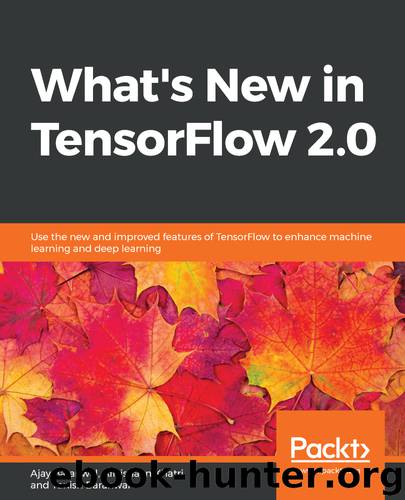Whats New in TensorFlow 2.0 by Ajay Baranwal

Author:Ajay Baranwal [Ajay Baranwal]
Language: eng
Format: epub, mobi
Tags: COM004000 - COMPUTERS / Intelligence (AI) and Semantics, COM044000 - COMPUTERS / Neural Networks, COM051360 - COMPUTERS / Programming Languages / Python
Publisher: Packt
Published: 2019-08-12T07:51:49+00:00
Technical requirements
It's assumed that readers of this chapter and this book know the basics of machine learning, neural networks, and deep neural networks. Also, as a prerequisite, it's assumed that readers know TensorFlow 1.x APIs. Further, a basic understanding of convolutional, recurrent, and feedforward layers in deep neural networks is required too.
Comparing Keras and tf.keras
tf.keras is TensorFlow's implementation of the Keras API specification. This is a high-level API to build and train models, which includes first-class support for TensorFlow-specific functionality, such as eager execution, tf.data pipelines, and estimators. tf.keras makes TensorFlow easier to use without sacrificing flexibility and performance.
Keras (the original website that defines the Keras API standard) has been an open source project that got tremendous attention from ML engineers and data scientists due to its simplicity and strength. Initially, the default backend engine for Keras (remember, Keras is a set of APIs) was Theano; however, lately, it has changed, with TensorFlow now as its default backend engine. You can also set the default backend engine to MXNet, CNTK, and so on. Keras APIs are extremely user-friendly, modular, and composable. Also, it's easy to extend for your specific needs. TensorFlow adopted Keras API standards and since then, the development of tf.keras using TensorFlow core functions has been going full swing. Now, with the release of TF 2.0, the TF development team has brought tight and efficient support of tf.keras high-level APIs. Also, it's worth mentioning that Keras and tf.keras are two entirely different packages and, as part of TF 2.0, tf.keras should be used. In terms of versioning, in TensorFlow 2.0, there is still a discrepancy with the version number of TensorFlow and tf.keras and you can try viewing this using tf.__version__ and tf.keras.__version__.
Download
This site does not store any files on its server. We only index and link to content provided by other sites. Please contact the content providers to delete copyright contents if any and email us, we'll remove relevant links or contents immediately.
| Computer Vision & Pattern Recognition | Expert Systems |
| Intelligence & Semantics | Machine Theory |
| Natural Language Processing | Neural Networks |
Algorithms of the Intelligent Web by Haralambos Marmanis;Dmitry Babenko(16234)
Jquery UI in Action : Master the concepts Of Jquery UI: A Step By Step Approach by ANMOL GOYAL(9386)
Test-Driven Development with Java by Alan Mellor(7735)
Data Augmentation with Python by Duc Haba(7608)
Principles of Data Fabric by Sonia Mezzetta(7378)
Learn Blender Simulations the Right Way by Stephen Pearson(7294)
Microservices with Spring Boot 3 and Spring Cloud by Magnus Larsson(7137)
Hadoop in Practice by Alex Holmes(6587)
RPA Solution Architect's Handbook by Sachin Sahgal(6515)
The Infinite Retina by Robert Scoble Irena Cronin(6216)
Big Data Analysis with Python by Ivan Marin(5933)
Life 3.0: Being Human in the Age of Artificial Intelligence by Tegmark Max(5514)
Pretrain Vision and Large Language Models in Python by Emily Webber(4894)
Infrastructure as Code for Beginners by Russ McKendrick(4653)
Functional Programming in JavaScript by Mantyla Dan(4436)
WordPress Plugin Development Cookbook by Yannick Lefebvre(4382)
The Age of Surveillance Capitalism by Shoshana Zuboff(4245)
Embracing Microservices Design by Ovais Mehboob Ahmed Khan Nabil Siddiqui and Timothy Oleson(4148)
Applied Machine Learning for Healthcare and Life Sciences Using AWS by Ujjwal Ratan(4135)
